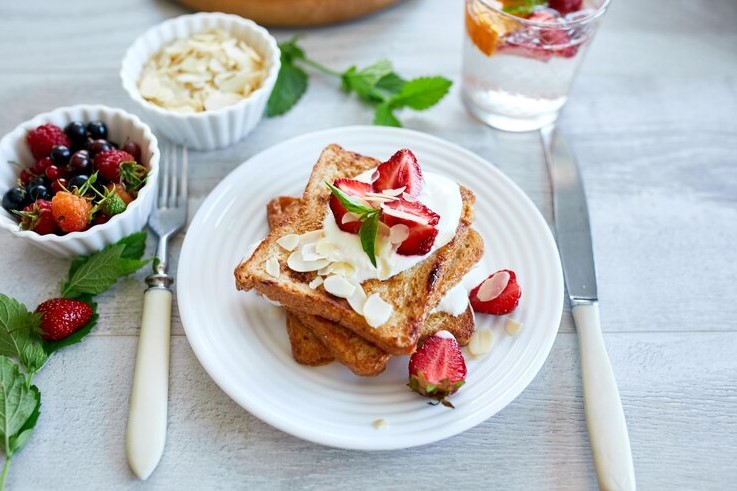Introduction to Anabolic French Toast
Overview of Anabolic French Toast
Anabolic French Toast is more than just a breakfast dish; it’s a nutritional powerhouse tailored for fitness enthusiasts and health-conscious individuals. This innovative twist on the classic French toast is designed to maximize protein intake while minimizing excess fats and sugars. Typically made with egg whites, low-calorie bread, and zero-calorie sweeteners, Anabolic French Toast is a perfect blend of taste and health. Its high-protein content makes it an ideal meal for muscle repair and growth, especially for those engaged in regular workouts or bodybuilding. The dish’s versatility allows for various toppings and flavors, making it a delightful and nutritious option for any meal of the day.
Popularity and Origins
The concept of Anabolic French Toast gained momentum through the fitness community, largely popularized by bodybuilders and fitness influencers like Greg Doucette. Its origins can be traced back to the need for a tasty yet healthy breakfast option that aligns with the dietary requirements of athletes and fitness enthusiasts. This need led to the reinvention of the traditional French toast into a more protein-rich and low-fat version, catering to those who are mindful of their macronutrient intake. Today, it’s not just a staple in the fitness world but also a favored choice among people seeking a balanced and fulfilling meal.
Benefits of Anabolic French Toast
Anabolic French Toast offers numerous health benefits, making it a superior choice over traditional breakfast options:
- High Protein Content: Essential for muscle building and repair, it provides a substantial amount of protein, crucial for those engaged in regular physical activity.
- Low in Calories and Fats: By using egg whites and low-calorie bread, it significantly reduces fat and calorie intake, aiding in weight management and promoting a lean physique.
- Satiety and Appetite Control: High protein and fiber content contribute to a feeling of fullness, reducing the likelihood of overeating and aiding in appetite control.
- Versatility and Taste: Despite its health benefits, it doesn’t compromise on taste, offering a delicious and satisfying meal that can be customized with various healthy toppings.
- Energy Boost: Provides a balanced combination of proteins and carbohydrates, offering sustained energy, making it an ideal start to the day for active individuals.
Ingredients and Nutritional Value
Key Ingredients
Anabolic French Toast is crafted from a selection of health-focused ingredients, each playing a crucial role in enhancing its nutritional profile:
- Egg Whites: The cornerstone of the recipe, egg whites are a pure protein source, virtually devoid of fats and carbohydrates.
- Low-Calorie Bread: Opting for low-calorie bread significantly reduces the overall calorie count without sacrificing the dish’s texture and volume.
- Zero-Calorie Sweeteners: These sweeteners, such as stevia or erythritol, offer the sweetness of sugar without the added calories, making the dish suitable for weight management.
- Cinnamon or Vanilla Extract: These add flavor without contributing unnecessary calories.
- Optional Protein Powder: For an extra protein boost, some recipes include a scoop of protein powder, enhancing the muscle-building properties of the meal.
Nutritional Breakdown
A typical serving of Anabolic French Toast boasts an impressive nutritional profile:
- Protein: Ranging from 20-30 grams per serving, primarily from egg whites and optional protein powder.
- Calories: Approximately 200-300 calories per serving, making it a low-calorie option for a filling breakfast.
- Carbohydrates: Around 20-30 grams, depending on the type of bread used.
- Fats: Minimal fat content, as egg whites replace whole eggs and no butter or oil is used in cooking.
- Fiber: The choice of bread can contribute to the dietary fiber content, aiding in digestion and satiety.
Comparison with Traditional French Toast
In contrast to traditional French toast, the anabolic version excels in health benefits:
- Protein Content: Unlike the traditional version, which has less protein, the anabolic variant is rich in protein.
- Caloric Density: Thanks to egg whites and low-calorie bread, Anabolic French Toast has a significantly lower calorie count.
- Fat Content: Traditional recipes typically use whole eggs, butter, and sugary toppings, leading to higher fat content, a stark difference from the leaner anabolic version.
Compared to traditional French toast, this anabolic version is significantly lower in calories and fats, making it a healthier choice. For a detailed breakdown of the nutritional content, check out Greg Doucette’s Anabolic French Toast Recipe.
Preparing Anabolic French Toast
Anabolic French Toast in a Fitness Diet
Role in Muscle Building and Weight Loss
Anabolic French Toast is a powerhouse in fitness diets, particularly for muscle building and weight loss:
- Muscle Building: The high protein content, primarily from egg whites, is crucial for muscle repair and growth. Protein is essential for rebuilding muscle fibers post-workout, making this dish an excellent choice for athletes and bodybuilders.
- Weight Loss: Low in calories and fats, Anabolic French Toast can be a satisfying part of a calorie-controlled diet. The protein and fiber from the bread keep you full longer, reducing the likelihood of snacking and aiding in appetite control.
- Energy Supply: It provides a balanced mix of proteins and carbohydrates, offering sustained energy for workouts and daily activities, without the heaviness of traditional, more calorie-dense breakfasts.
Incorporating into Different Diets (Keto, Vegan, etc.)
- Keto: For a keto-friendly version, use low-carb bread and ensure any added protein powder is low in carbs.
- Vegan: Replace egg whites with a vegan egg substitute or a flax egg, and use vegan bread.
- Gluten-Free: Opt for gluten-free bread if you have gluten sensitivities or celiac disease.
- Lactose-Free: This recipe is naturally lactose-free, making it suitable for those with lactose intolerance.
Meal Planning and Prep Tips
- Batch Cooking: Make a large batch of the egg mixture and refrigerate it for easy breakfast preparation all week.
- Freezing: Cooked Anabolic French Toast can be frozen. Reheat in a toaster or oven for a quick, nutritious breakfast.
- Portion Control: For weight management, be mindful of portion sizes and the caloric content of toppings.
- Balanced Meals: Serve the toast with fruits or vegetables to add vitamins and fiber, ensuring a balanced meal.
- Variety: Rotate between different bread types and toppings to keep the meal interesting and nutritionally diverse.
FAQs
Common Questions and Answers
- Q: What makes Anabolic French Toast different from regular French toast?
- A: Anabolic French Toast is designed for high nutritional value, particularly in protein content. It typically uses egg whites and low-calorie bread, making it lower in fats and calories compared to regular French toast, which often includes whole eggs, milk, and sugar.
- Q: Can Anabolic French Toast fit into a weight loss diet?
- A: Absolutely. Due to its high protein content and low calorie count, it’s an excellent choice for those on a weight loss diet. The protein helps in feeling full longer, reducing the urge to snack.
- Q: Is Anabolic French Toast suitable for vegetarians or vegans?
- A: For vegetarians, it’s a suitable option. Vegans can modify the recipe by using plant-based egg substitutes and vegan bread.
- Q: Can I make Anabolic French Toast without egg whites?
- A: Yes, you can use alternatives like flax eggs or commercial egg substitutes. However, this might change the protein content of the dish.
- Q: How can I add more flavor to Anabolic French Toast without adding too many calories?
- A: Use calorie-free flavorings like cinnamon, vanilla extract, or almond extract. Toppings like fresh fruits, Greek yogurt, or sugar-free syrups also add flavor without too many extra calories.
- Q: Is it possible to make Anabolic French Toast gluten-free?
- A: Yes, simply use gluten-free bread. The rest of the ingredients are naturally gluten-free.
- Q: Can I prepare Anabolic French Toast in advance?
- A: Yes, you can prepare the egg mixture in advance and store it in the refrigerator. The cooked toast can also be refrigerated or frozen and reheated when needed.
Conclusion and Additional Resources
Summary and Final Thoughts
Anabolic French Toast is more than just a breakfast item; it’s a nutritious, protein-rich meal that fits perfectly into various diets, from muscle building to weight loss. Its versatility in ingredients and preparation makes it a favorite among fitness enthusiasts and health-conscious individuals alike. By incorporating this dish into your diet, you’re choosing a meal that’s not only delicious but also aligns with your health and fitness goals. Anabolic French Toast proves that eating healthily doesn’t mean sacrificing flavor or enjoyment.
Additional Resources and References
For more information on high-protein diets and fitness nutrition, websites like Healthline offer a wealth of resources. Furthermore, fitness channels on YouTube, featuring dietitians and personal trainers, offer valuable insights and diverse variations on recipes like Anabolic French Toast.
If you’re interested in exploring more healthy and delicious breakfast options, don’t miss our guide on :


